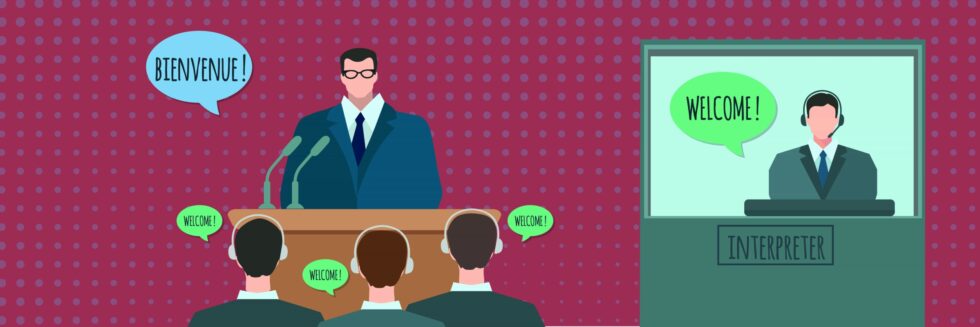
Becoming an interpreter is no easy feat. In addition to being bilingual, professional interpreters need specialized training, strong communication skills, and a great memory. Yet only one type must learn to switch between two methods of interpreting: the conference interpreter. In this blog post, we explore the world of conference interpreters and the unique role they play in interlingual communication.
What Is a Conference Interpreter?
Like the name states, conference interpreters translate spoken messages from one language into another at conferences, meetings, and other events. Their clients include government agencies, international organizations, and multinational corporations. Conference interpreters typically conduct sessions in-person, but remote conference interpreting is becoming more common.
During a session, a conference interpreter may use simultaneous interpreting (SI), consecutive interpreting (CI), or switch between the two methods—depending on the client’s needs. For example, when someone is giving a speech or a group is having a debate, the interpreter will use the simultaneous method. However, if a client wishes to communicate one-on-one with another attendee, the interpreter will switch to the consecutive method. A conference interpreter may also use consecutive interpreting when there is only one speaker at an event.
Simultaneous Interpreting vs. Consecutive Interpreting
But to truly appreciate conference interpreters, you need to know the difference between simultaneous interpreting and consecutive interpreting.
Simultaneous interpreting involves delivering a spoken translation in real-time, which requires interpreting while the speaker is talking. It’s usually carried out by a team of two interpreters who switch every 20 to 30 minutes. While one person interpreters, the other plays a supporting role by taking notes and looking up terms. When onsite, they work in sound proof booths and deliver the interpretation through a transmitter.
A few challenges of simultaneous interpreting include:
- Time pressure—the gap between what the speaker says and the translation is around two seconds.
- Accents and speed of delivery—the interpreter must adjust to the speaker’s manner of speech.
- Lack of clarification—SI interpreters can’t ask the speaker to repeat themselves.
SI interpreters also need to predict what the speaker will say before they say it. That requires more cognitive effort and focus than consecutive interpreting.
Consecutive interpreting, on the other hand, involves delivering a spoken translation after the speaker has finished talking. In conference settings, CI interpreters interpret sections or “chunks” of speech that may last from 5 to 10 minutes, sometimes longer. To ensure accuracy, they take extensive notes while the speaker is talking. When onsite, they face the audience while they work.
A few challenges of consecutive interpreting include:
- Note-taking—CI interpreters must develop a highly-developed note-taking system.
- Exposure—CI interpreters must be comfortable in front of an audience.
- Longer sessions—since CI interpreters typically work alone, they need to prepare to interpret for the length of the speech or meeting.
Outside of conference settings, CI interpreters often work in high-stress environments such as hospitals and courtrooms, which requires the ability to remain calm under pressure.
Finding Good Conference Interpreters
As you can see, conference interpreters are a unique breed. They must be quick thinkers, have extensive knowledge of the topic presented, and be comfortable in front of an audience. Fortunately, a language services company can connect you with conference interpreters who are the perfect fit for your event.
At INGCO International, we have a worldwide network of conference interpreters who speak over 200 languages. Not only will we hand pick the right interpreters, but we can also provide rental equipment and turn-key solutions for your event.
Want to learn more about how INGCO International can make your next multilingual event a success? Contact us today
